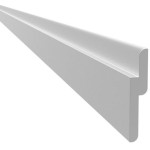The most obvious place where you will see Slatwall (also known as slotwall) in action is when you go into a store and browse the articles displayed for sale by hanging them from a wall. Back in time, items for sale may have been hung up for display on basic hooks; but, these days the shop owner is more likely to have made his hanging display more eye catching and appealing to customers than a simple hook: Slatwall is one way to achieve this.
Early Slatwall was made from medium density fiberboard (MDF) with a plastic laminate on, at least, one side. The outer, display, side had horizontal grooves cut into it. Plastic or aluminum inserts could then be placed into the grooves. These would – both slide along the groove – and provide the hanger for the product on display. Alternatively, the grooves could have shelf holders inserted into them so that goods that are not suitable for hanging can stand on the shelves.
Usually, the Slatwall would be fixed to a back or side wall of the store in the same manner as basic wall cladding panels but they could also be used as faces making up an aisle partition within the store. With boundless possibilities for groove size and position and a huge number of insert fittings to choose from, Slatwall can be customized to display almost anything that a store might be selling – even an auto dealership could use it to display spare parts, accessories, lubricants, etc.
Short comings Of Medium Density Fiberboard
MDF can deteriorate quite quickly under humid or moist conditions; laminated surface finishes can peel off, grooves can become worn or damaged – there are quite a number of possible drawbacks associated with this material when used for statwalling. This raises the question of – is there a better material from which to produce the basic Statwall?
The Aluminum Alternative
Whether in its natural state (straight from an aluminum extrusion press) or, after anodising or other finishing techniques have been applied, aluminum is considerably more durable and easier to keep in good, clean condition than MDF. Maybe you are thinking that an aluminum extrusion cannot be anywhere near the width of an MDF sheet (even if it can be considerably longer)? Your thought would be correct but that is not a cause for concern. Your aluminum Slatwall may have between one and four grooves and only be a few inches wide but you can fix several of them, suitably spaced, up the wall until you have the number of available grooves required for your display intentions.
When looking for aluminum Slatwall and all the necessary accessories; you should investigate the wide selection available from Eagle Mouldings Specialty Aluminum Trims & Extrusions. Check them out on the web.




